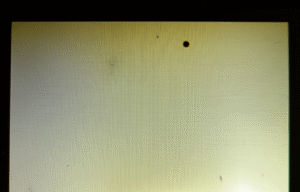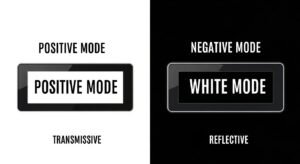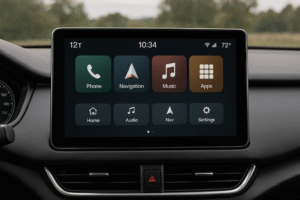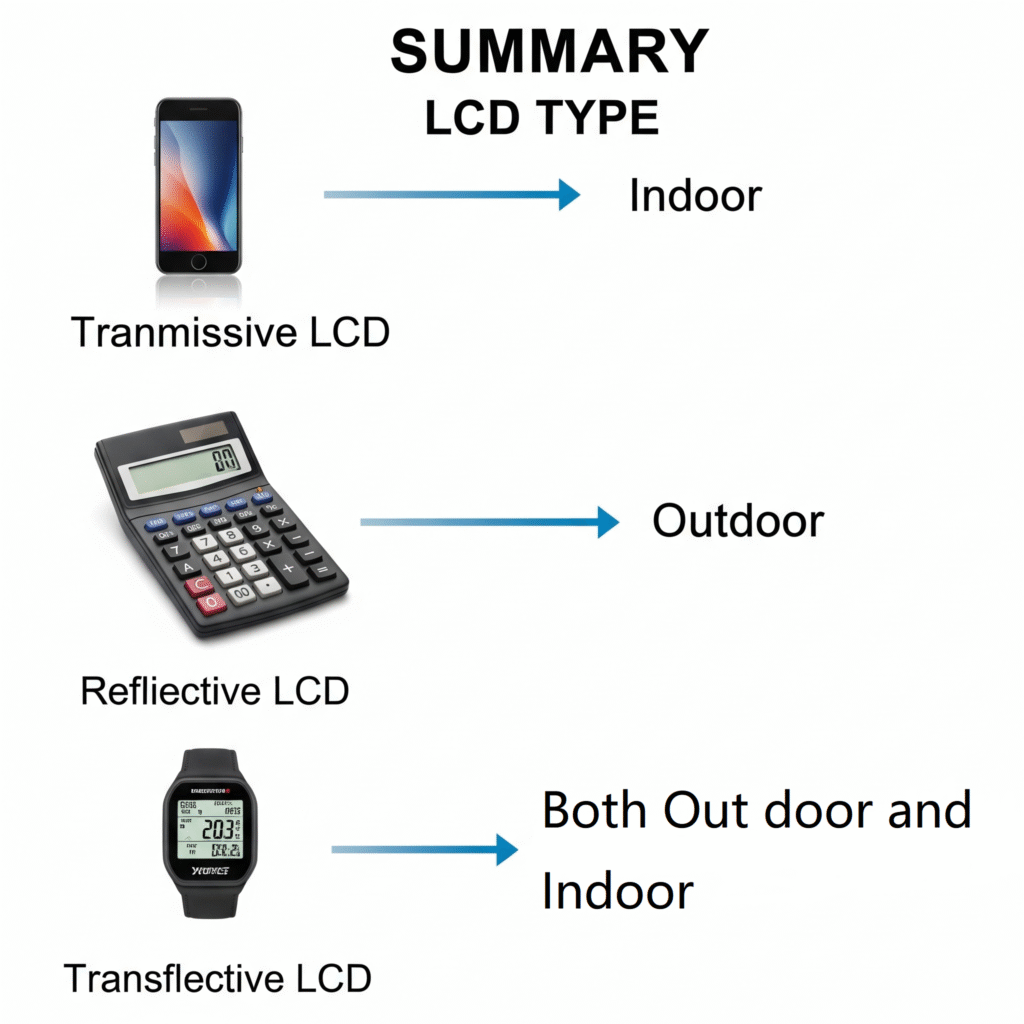
Choosing the right LCD for your product is a crucial decision. As someone who has advised many customers in the electronic display industry, I know that the choice is rarely simple. The confusion usually comes from not knowing how transmissive, reflective, and transflective LCDs actually use light. Simply put, transmissive LCDs depend on a backlight, reflective LCDs work by using ambient light, and transflective LCDs combine the strengths of both.
Transmissive LCDs require a backlight, reflective LCDs use ambient light for visibility, and transflective LCDs use both technologies so your screen can be seen clearly whether you are inside or outside.
I remember a key lesson from my early days: a device we designed failed completely outdoors because its transmissive display disappeared in sunlight. Since then, I always help clients match their LCD type to their actual usage conditions to avoid such mistakes.
How Does a Transmissive LCD Create an Image?
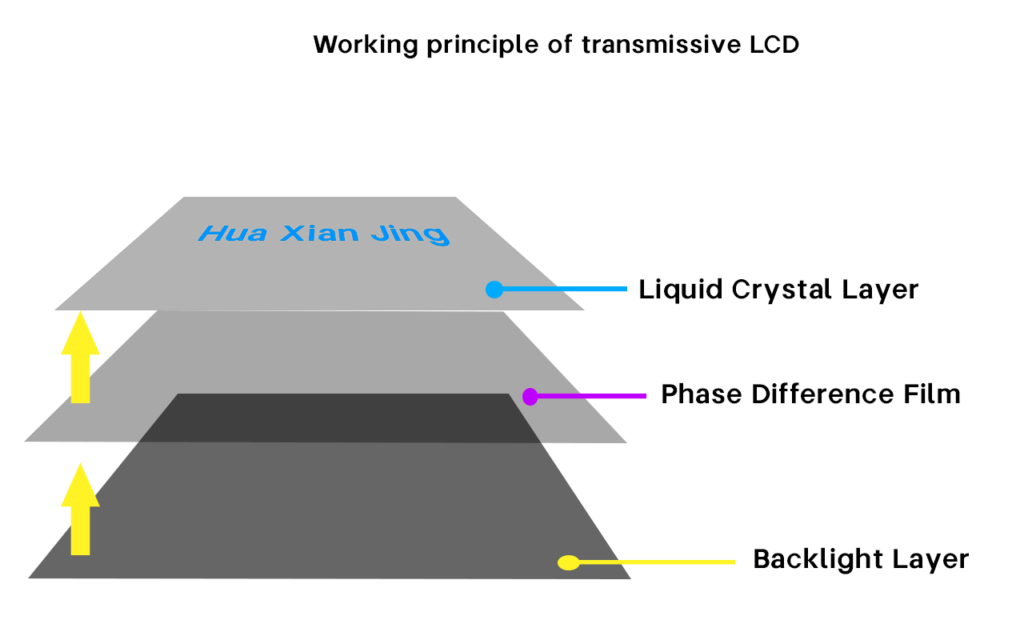
Transmissive LCDs are everywhere—in laptops, smartphones, and monitors—mostly used for indoor viewing.
A transmissive LCD uses a backlight to shine through liquid crystals and color filters, forming a visible image. This makes them great for indoor use where controlled lighting is common.
Here’s what happens inside: a backlight sits behind the liquid crystal layer. Liquid crystals change their alignment with electrical signals, acting as shutters for each pixel. Color filters on top produce full color displays. Because the backlight provides all the light, colors are bright and images are sharp indoors. However, under strong sunlight, the external brightness overwhelms the backlight, making the image washed out or invisible.
Color filters on top produce full color displays. Because the backlight provides all the light, colors are bright and images are sharp indoors. However, under strong sunlight, the external brightness overwhelms the backlight, making the image washed out or invisible.
| Feature | Description |
|---|---|
| Brightness | High indoors, poor in sunlight |
| Power Use | High, due to constant backlight |
| Application | TVs, monitors, smartphones, tablets |
| Color Quality | Vivid, wide color range |
Transmissive LCDs are preferred when you need high color quality, full video, and wide viewing angles indoors. But remember, they consume more power since the backlight is always on, and their performance drops in direct sunlight.
How Does a Reflective LCD Work Without a Backlight?

Reflective LCDs may seem basic but have unique advantages, especially outdoors.
A reflective LCD uses a mirror-like layer to reflect ambient light through the liquid crystals, allowing the display to form images without any backlight.
Ambient light enters the front of the display, passes through the liquid crystals, reflects off the rear mirror layer, and returns to your eyes. The crystals block or allow this reflected light to form digits, letters, or simple graphics. Reflective LCDs excel in outdoor or high-brightness environments. You will find them in calculators, e-labels, outdoor meters, and some low-power devices. The downside is they are difficult to read in low light or darkness because they have no internal light source.
- Great for static or basic graphics
- Sunlight-readable and glare-resistant
- Minimal power use (just to change the display)
| Advantage | Description |
|---|---|
| Sunlight Readability | Excellent, even in direct sunlight |
| Power Consumption | Extremely low, no backlight needed |
| Color/Graphics | Limited, usually monochrome |
Reflective LCDs are ideal for battery-powered or outdoor devices where long operation and sunlight visibility matter most.
How Does a Transflective LCD Balance Both Worlds?

Transflective LCDs are designed for flexible use, adapting to all lighting conditions.
A transflective LCD combines a backlight and a semi-reflective layer, making the screen visible both indoors (using the backlight) and outdoors (using reflected light).
These displays feature a special film behind the crystals that partly reflects ambient light and partly lets backlight through. Indoors or at night, the backlight makes the image clear. Outside or in strong ambient light, the backlight can be dimmed or turned off, and the reflective film keeps the image visible. You’ll find transflective LCDs in GPS units, smartwatches, automotive dashboards, and outdoor terminals. While not as bright as transmissive LCDs in a dark room or as high-contrast as a pure reflective LCD in sunlight, transflective types are the best compromise when your device needs to work everywhere.
| Device Type | Why Use Transflective LCD? |
|---|---|
| GPS Device | Sunlight readable, battery-saving |
| Outdoor Smartwatch | Visible everywhere, efficient |
| Car Dashboard | Day and night usability |
| Industrial Handheld | Works in changing lighting environments |
What Are the Advantages and Disadvantages of Each LCD Type?
Each LCD type fits a specific use case, with its own pros and cons.
Transmissive LCDs are best for vivid indoor displays, reflective LCDs for bright sunlight and minimal power use, while transflective LCDs offer balanced performance in all lighting but with slight trade-offs.
| Type | Indoors | Sunlight | Power Use | Color Quality | Use Cases |
|---|---|---|---|---|---|
| Transmissive | Best | Poor | High | Vivid | TVs, laptops, phones |
| Reflective | Poor | Best | Lowest | Basic | Outdoor, meters, tags |
| Transflective | Good | Good | Low/Med | Moderate | GPS, watches, vehicles |
Transmissive LCDs give you rich colors, but drain battery and are not sunlight readable. Reflective LCDs let you read the screen in the sun and save energy but look faded indoors. Transflective LCDs are a hybrid—great for mixed-use but not quite perfect for any single environment.
Technical Insights into LCD Design
How an LCD is built affects its real-world performance.
Polarizer type, backlight strength, and reflective layers all determine how an LCD manages light, image quality, and power draw.
- Transmissive: Transparent polarizer, strong internal backlight, no reflective backing.
- Reflective: Mirror backing, no backlight, reflective polarizer.
- Transflective: Semi-reflective film behind the crystals, optional backlight, special polarizer.
For custom designs, you can choose between different LCD types based on product needs. TFT LCDs can be produced as transmissive, reflective, or transflective, depending on your requirements. Understanding these differences helps avoid mistakes, like building a handheld meant for outdoors using the wrong LCD mode.
What Problems Do These LCD Types Solve and How?
Choosing the wrong LCD can result in unreadable screens, poor battery life, or unhappy users. Each LCD type solves a real-world problem.
Transmissive LCDs give you vibrant colors indoors, reflective LCDs solve sunlight visibility and battery life, and transflective LCDs deliver one screen you can use almost anywhere.
| Problem | Best LCD Type | Reason |
|---|---|---|
| Outdoor readability | Reflective | Sunlight visible, low power |
| Vivid color for presentations | Transmissive | Bright, color-rich display |
| Both indoor and outdoor use | Transflective | Adaptable to all environments |
| Battery-saving for e-label | Reflective | Minimal power needed |
If you build a device for field workers, transflective or reflective is a better choice. If you want rich color for a conference room, go transmissive. For an e-price label or calculator, reflective LCD is best.
Conclusion
Choose your LCD type based on real use—think about where, when, and how your product will be used. Each LCD style has a clear advantage in the right scenario.
Related Articles:
Understanding and Troubleshooting Segment LCD Failures?
Defference Of Self, Mutual, Projected Capacitive Touchscreen
A Guide to LCD Display Connector Types and Their Features
IPS vs. OLED: Which Display Technology Is Right for You?
TN, STN, STN, FSTN, STN and EBTN LCD: What Are The Differences?
FAQ
Can I use a transmissive LCD outdoors?
No, transmissive LCDs are hard to read in sunlight. Use reflective or transflective types for outdoor use.
Why do some displays not need a backlight?
Reflective LCDs form images using only ambient light and a mirror layer, no backlight required.
Is transflective always the best solution?
Transflective LCDs are flexible but offer less brightness or contrast than the best transmissive or reflective displays.
Which LCD uses the least power?
Reflective LCDs consume the least power since they lack a backlight and only need energy to change pixels.
Can LCD modules be customized for special lighting needs?
Yes, many manufacturers can design LCD modules in any of these modes to suit different lighting or usage requirements.



